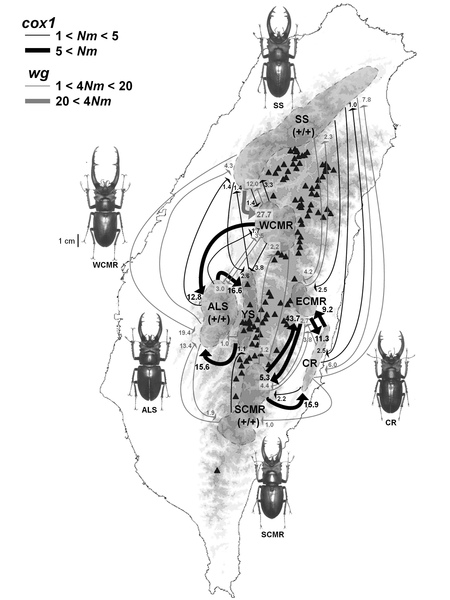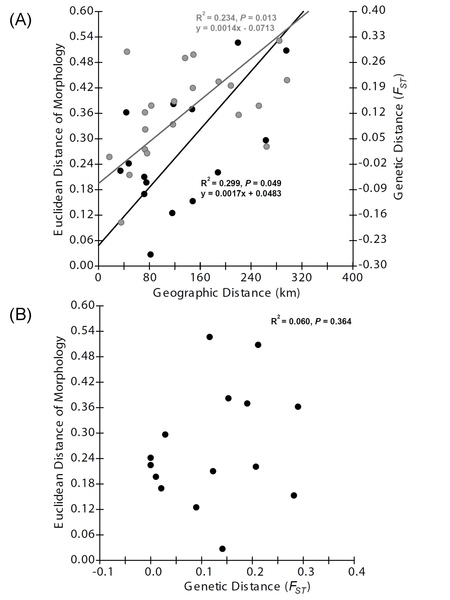close
自己做為主要作者的第一篇文章出來了!
Diversification in subtropical mountains: Phylogeography, Pleistocene demographic expansion, and evolution of polyphenic mandibles in Taiwanese stag beetle, Lucanus formosanus
Molecular Phylogenetics and Evolution, 57, 1149-1160
Pleistocene glacial oscillations have had profound impacts on the historical population dynamics of extant species. However, the genetic consequences of past climatic changes depend largely on the latitude and topography of the regions in question. This study investigates the effect of Pleistocene glacial periods and the Central Mountain Range on the phylogeography, historical demography, and phenotypic differentiation of a montane forest-dwelling stag beetle, Lucanus formosanus (Coleoptera: Lucanidae), which exhibits extensive mandible variations across mountain ranges in subtropical Taiwan. Analyses of mitochondrial (cox1) and nuclear (wg) loci reveal that L. formosanus originated nearly 1.6 million years ago (Mya) in the early Pleistocene period and consisted of geographically overlapping Alishan and Widespread clades. A drastic population expansion starting approximately 0.2 Mya in the Widespread clade likely resulted from altitudinal range shift of the temperate forests, which was closely tied to the arrival of the Riss glacial period in the late Middle Pleistocene. A ring-like pattern of historical gene flow among neighboring populations in the vicinity of the Central Mountain Range indicates that the mountains constitute a strong vicariant barrier to the east–west gene flow of L. formosanus populations. A geographic cline of decreasing mandible size from central to north and south, and onto southeast of Taiwan is inconsistent with the low overall phylogeographic structures. The degree of mandible variation does not correlate with the expected pattern of neutral evolution, indicating that the evolutionary diversification of this morphological weapon is most likely subject to sexual or natural selection. We hypothesize that the adaptive evolution of mandibles in L. formosanus is shaped largely by the habitat heterogeneity.
主要講的是台灣深山鍬形蟲在台灣各個山脈間一直被紀錄有不一樣的長相,而我們用分子證據發現其實各個族群之間的分化並不大,雖然有中央山脈檔在中間,但是族群間應該還是有不小的基因交流。這樣的發現和外表上的型態分化不符合,而這就是我們討論裡面寫的主要內容,與環境異質性有關,在各山脈中族群的基本居住環境因子不同,才會造成現在不同山脈間分化的表型。

文章裡面的一張圖,讓大家看各個地點雄蟲的長相(圖片來自楊福臨先生),配合上估計出來的山脈間族群基因交流量。

各族群間的遺傳差異和型態差異都與地理上的間隔有關,但是型態差異與遺傳差異並沒有顯著的相關性。
Diversification in subtropical mountains: Phylogeography, Pleistocene demographic expansion, and evolution of polyphenic mandibles in Taiwanese stag beetle, Lucanus formosanus
Molecular Phylogenetics and Evolution, 57, 1149-1160
Pleistocene glacial oscillations have had profound impacts on the historical population dynamics of extant species. However, the genetic consequences of past climatic changes depend largely on the latitude and topography of the regions in question. This study investigates the effect of Pleistocene glacial periods and the Central Mountain Range on the phylogeography, historical demography, and phenotypic differentiation of a montane forest-dwelling stag beetle, Lucanus formosanus (Coleoptera: Lucanidae), which exhibits extensive mandible variations across mountain ranges in subtropical Taiwan. Analyses of mitochondrial (cox1) and nuclear (wg) loci reveal that L. formosanus originated nearly 1.6 million years ago (Mya) in the early Pleistocene period and consisted of geographically overlapping Alishan and Widespread clades. A drastic population expansion starting approximately 0.2 Mya in the Widespread clade likely resulted from altitudinal range shift of the temperate forests, which was closely tied to the arrival of the Riss glacial period in the late Middle Pleistocene. A ring-like pattern of historical gene flow among neighboring populations in the vicinity of the Central Mountain Range indicates that the mountains constitute a strong vicariant barrier to the east–west gene flow of L. formosanus populations. A geographic cline of decreasing mandible size from central to north and south, and onto southeast of Taiwan is inconsistent with the low overall phylogeographic structures. The degree of mandible variation does not correlate with the expected pattern of neutral evolution, indicating that the evolutionary diversification of this morphological weapon is most likely subject to sexual or natural selection. We hypothesize that the adaptive evolution of mandibles in L. formosanus is shaped largely by the habitat heterogeneity.
主要講的是台灣深山鍬形蟲在台灣各個山脈間一直被紀錄有不一樣的長相,而我們用分子證據發現其實各個族群之間的分化並不大,雖然有中央山脈檔在中間,但是族群間應該還是有不小的基因交流。這樣的發現和外表上的型態分化不符合,而這就是我們討論裡面寫的主要內容,與環境異質性有關,在各山脈中族群的基本居住環境因子不同,才會造成現在不同山脈間分化的表型。

文章裡面的一張圖,讓大家看各個地點雄蟲的長相(圖片來自楊福臨先生),配合上估計出來的山脈間族群基因交流量。

各族群間的遺傳差異和型態差異都與地理上的間隔有關,但是型態差異與遺傳差異並沒有顯著的相關性。
全站熱搜


 留言列表
留言列表
